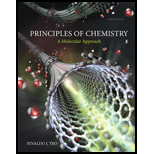
Interpretation:
The compounds soluble in hexane are to be identified.
Concept introduction: The polarity of solute and solvent determines the solubility of solution. Solute and solvent of same polarity are soluble with each other and insoluble if polarity is different.
To determine: The compounds soluble in hexane.
Answer to Problem 12.1P
Solution:
- Water is not soluble in hexane.
- Propane is soluble in hexane.
- Ammonia is not soluble in hexane.
- Hydrogen chloride is not soluble in hexane.
(a)
Explanation of Solution
The molecular structure of water consists of two hydrogen atoms bonded with one oxygen atom. The oxygen atom being electronegative element withdraw electrons from hydrogen atoms and become partial negatively charged.
However, hexane is a non-polar molecule and it does not solubilize polar compounds. Therefore, Water is not soluble in hexane.
(b)
Propane consists of three carbon atoms attached to each other in chain. The dipole moment of same elements bonded with each other is zero. Hence propane is a non-polar molecule and can solubilize in non-polar hexane.
(c)
The three hydrogen atoms in ammonia are bonded with nitrogen atom having one pair of electrons. The structure of the molecule is not symmetrical and nitrogen withdraws electrons towards itself.
Hence, ammonia is a polar molecule. Therefore, it is not soluble in hexane.
(d)
The electronegativity of chlorine in
However, hexane is a non-polar molecule and it does not solubilize polar compounds. Therefore, hydrogen chloride is not soluble in hexane.
Want to see more full solutions like this?
Chapter 12 Solutions
Principles of Chemistry: A Molecular Approach (3rd Edition)
 ChemistryChemistryISBN:9781305957404Author:Steven S. Zumdahl, Susan A. Zumdahl, Donald J. DeCostePublisher:Cengage Learning
ChemistryChemistryISBN:9781305957404Author:Steven S. Zumdahl, Susan A. Zumdahl, Donald J. DeCostePublisher:Cengage Learning ChemistryChemistryISBN:9781259911156Author:Raymond Chang Dr., Jason Overby ProfessorPublisher:McGraw-Hill Education
ChemistryChemistryISBN:9781259911156Author:Raymond Chang Dr., Jason Overby ProfessorPublisher:McGraw-Hill Education Principles of Instrumental AnalysisChemistryISBN:9781305577213Author:Douglas A. Skoog, F. James Holler, Stanley R. CrouchPublisher:Cengage Learning
Principles of Instrumental AnalysisChemistryISBN:9781305577213Author:Douglas A. Skoog, F. James Holler, Stanley R. CrouchPublisher:Cengage Learning Organic ChemistryChemistryISBN:9780078021558Author:Janice Gorzynski Smith Dr.Publisher:McGraw-Hill Education
Organic ChemistryChemistryISBN:9780078021558Author:Janice Gorzynski Smith Dr.Publisher:McGraw-Hill Education Chemistry: Principles and ReactionsChemistryISBN:9781305079373Author:William L. Masterton, Cecile N. HurleyPublisher:Cengage Learning
Chemistry: Principles and ReactionsChemistryISBN:9781305079373Author:William L. Masterton, Cecile N. HurleyPublisher:Cengage Learning Elementary Principles of Chemical Processes, Bind...ChemistryISBN:9781118431221Author:Richard M. Felder, Ronald W. Rousseau, Lisa G. BullardPublisher:WILEY
Elementary Principles of Chemical Processes, Bind...ChemistryISBN:9781118431221Author:Richard M. Felder, Ronald W. Rousseau, Lisa G. BullardPublisher:WILEY





